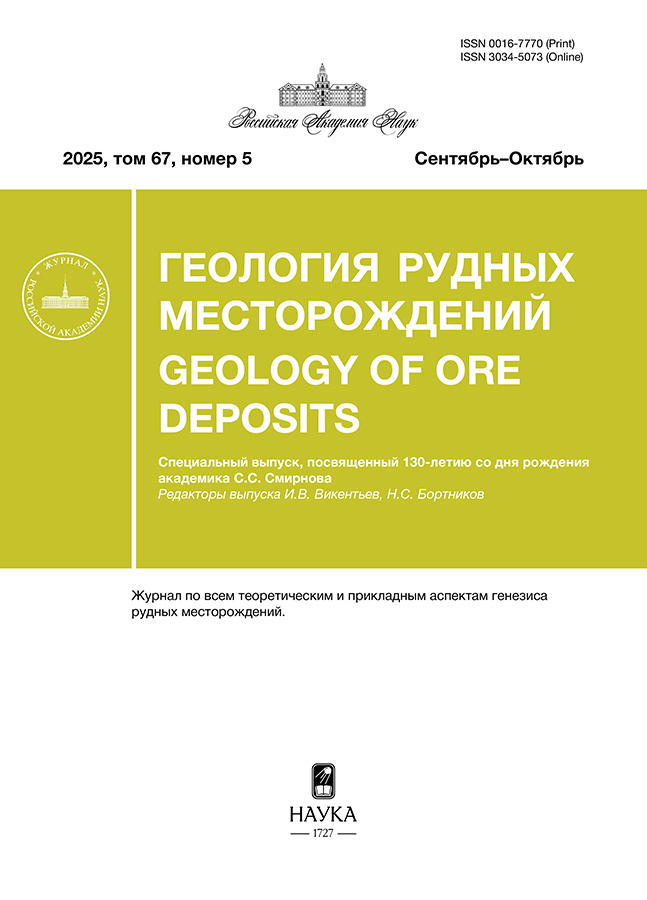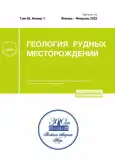Медь в гидротермальных системах: термодинамическое описание компонентов системы Cu(I)–O–H
- Авторы: Акинфиев Н.Н.1,2, Зотов А.В.1
-
Учреждения:
- Институт геологии рудных месторождений, петрографии, минералогии и геохимии РАН
- Российский государственный геологоразведочный университет имени С. Орджоникидзе
- Выпуск: Том 65, № 1 (2023)
- Страницы: 4-14
- Раздел: Статьи
- URL: https://journals.rcsi.science/0016-7770/article/view/134666
- DOI: https://doi.org/10.31857/S0016777023010021
- EDN: https://elibrary.ru/LARZSH
- ID: 134666
Цитировать
Полный текст
Аннотация
Проведена обработка имеющихся в литературе экспериментальных данных по растворимости Cu (мет.) и Cu2O (куприт) в воде в гидротермальных условиях. Проведены ключевые эксперименты по растворимости куприта при 300°C, давлении насыщенного пара H2O в зависимости от pH раствора. В результате получен набор значений термодинамических свойств для 25°С, 1 бар и параметров уравнения моделей НКF (Хелгесон–Киркхэм–Флауэрс) и AD (Акинфиев–Даймонд) для гидроксокомплексов Cu(I), позволяющие описывать их поведение в широком диапазоне температур (0–600°C), давлений (1–3000 бар) и плотностей водного флюида (0.01–1 г см–3). Методами термодинамического моделирования показано, что ион Cu+ является доминирующим в кислой и слабощелочной области водного растворителя во всем исследованном диапазоне температур и давлений. Влияние нейтрального гидроксокомплекса CuOH начинает сказываться в щелочной области при T > 300°C и растет с увеличением температуры. Второй гидроксокомплекс меди \({\text{Cu}}\left( {{\text{OH}}} \right)_{2}^{ - }\) проявляет себя лишь в сильнощелочной области, причем температура практически не влияет на его поведение.
Ключевые слова
Об авторах
Н. Н. Акинфиев
Институт геологии рудных месторождений, петрографии, минералогии и геохимии РАН; Российский государственный геологоразведочный университет имени С. Орджоникидзе
Email: akinfiev@igem.ru
Россия, 119017, Москва, Старомонетный пер., 35; Россия, 117997, Москва, ул. Миклухо-Маклая, 23
А. В. Зотов
Институт геологии рудных месторождений, петрографии, минералогии и геохимии РАН
Автор, ответственный за переписку.
Email: akinfiev@igem.ru
Россия, 119017, Москва, Старомонетный пер., 35
Список литературы
- Акинфиев Н.Н, Воронин М.В., Зотов А.В., Прокофьев В.Ю. Экспериментальное исследование устойчивости хлорборатного комплекса и термодинамическое описание водных компонентов в системе B–Na–Cl–O–H до 350°С // Геохимия. 2006. № 9. С. 937–949.
- Варьяш Л.Н. Экспериментальное изучение равновесий в системе Cu–Cu2O–H2O в интервале температур 150–450°C // Геохимия. 1989. № 3. С. 412–422.
- Рубцова Е.А., Тагиров Б.Р. и др. Совместная растворимость Cu и Ag в хлоридных гидротермальных флюидах (350–650°C, 1000–1500 бар) // Геология руд. месторождений. 2023. В печати.
- Akinfiev N.N., Diamond L.W. Thermodynamic description of aqueous nonelectrolytes at infinite dilution over a wide range of state parameters // Geochim. Cosmochim. Acta, 2003. V. 67. №. 4. P. 613–627.https://doi.org/10.1016/s0016-7037(02)01141-9
- Akinfiev N.N., Plyasunov A.V. Application of the Akinfiev–Diamond equation of state to neutral hydroxides of metalloids (B(OH)3, Si(OH)4, As(OH)3) at infinite dilution in water over a wide range of the state parameters, including steam conditions. // Geochim. Cosmochim. Acta, 2014. V. 126. P. 338–351.https://doi.org/10.1016/j.gca.2013.11.013
- Born, Von M. Volumen und Hydratationswärme der Ionen. // Zeitschr. Physik, 1920. V. 1. P. 45–48.
- Frisch M.J. et al. Gaussian 09, Revision C.01. Gaussian, Inc., Wallingford CT, 2009.
- Helgeson H.C., Kirkham D.H., Flowers G.C. Theoretical prediction of the thermodynamic behavior of aqueous electrolytes at high pressures and temperatures: IV. Calculation of activity coefficients, osmotic coefficients, and apparent molal and standard and relative partial molal properties to 600°C and 5 kb // Am. Jour. Sci. 1981. V. 291. P. 1249–1516.
- Helgeson H.C., Kirkham D.H., Flowers G.C. Theoretical prediction of the thermodynamic behavior of aqueous electrolytes by high pressures and temperatures; IV. Calculation of activity coefficient, osmotic coefficients, and apparent molal and standard and relative partial molal properties to 600°C and 5 KB // Am. Jour. Sci. 1981. V. 291. P. 1249–1516.
- Johnson J.W., Oelkers E.H., Helgeson H.C. SUPCRT92: A software package for calculating the standard molal thermodynamic properties of minerals, gases, aqueous species, and reactions from 1 to 5000 bars and 0° to 1000°C // Comp. Geosci. 1992. V. 18. P. 899–947.
- Marenich A.V., Cramer C.J., Truhlar D.G. Universal solvation model based on solute electron density and on a continuum model of the solvent defined by the bulk dielectric constant and atomic surface tensions // J. Phys. Chem. B. 2009. V. 113. P. 6378–6396.
- Messerly R.A., Yoon T.J., Jadrich R.B., Currier R.P., Maerzke K.A. Elucidating the temperature and density dependence of silver chloride hydration numbers in high-temperature water vapor: A first-principles molecular simulation study // Chem. Geol. V. 594. P. 120766. https://doi.org/10.1016/j.chemgeo.2022.120766
- Palmer D.A. Solubility Measurements of Crystalline Cu2O in Aqueous Solution as a Function of Temperature and pH // J. Solution Chem. 2011. V. 40. P. 1067–1093. https://doi.org/10.1007/s10953-011-9699-x
- Pocock F. J., Stewart J. F. The Solubility of Copper and Its Oxides in Supercritical Steam // Journal of Engineering for Power, 1963. V. 85. № 1. P. 33–44. https://doi.org/10.1115/1.3675213
- Robie R.A., Hemingway B.S. Thermodynamic properties of minerals and related substances at 298.15 and 1 bar (105 pascals) pressure and at high temperatures // U. S. Geol. Surv. Bull. 1995. P. 2131.
- Shannon R.D. Revised effective ionic radii and systematic studies of interatomic distances in halides and chalcogenides // Acta Cryst. V. A32. P. 751–767.
- Shock E.L., Helgeson H C., Sverjensky D.A. Calculation of the thermodynamic properties of aqueous species at high pressures and temperatures: Standard partial molal properties of inorganic neutral species // Geochim. Cosmochim. Acta. 1989. V. 53. P. 2157–2183.
- Shock E.L., Helgeson H.C. Calculation of the thermodynamic and transport properties of aqueous species at high pressures and temperatures: Correlation algorithms for ionic species and equation of state predictions to 5 kb and 1000°C // Geochim. Cosmochim. Acta. 1988. V. 52. P. 2009–2036.
- Shock E.L., Sassani D.C., Willis M., Sverjensky D.A. Inorganic species in geologic fluids: Correlations among standard molal thermodynamic properties of aqueous ions and hydroxide complexes // Geochim. Cosmochim. Acta. 1997. V. 61. P. 907–950.
- Shock E.L., Sassani D.C., Willis M., Sverjensky D.A. Inorganic species in geologic fluids: Correlations among standard molal thermodynamic properties of aqueous ions and hydroxide complexes // Geochim. Cosmochim. Acta. 1997. V. 61. P. 907–950.
- Shvarov Yu.V. A suite of programs, OptimA, OptimB, OptimC, and OptimS compatible with the Unitherm database, for deriving the thermodynamic properties of aqueous species from solubility, potentiometry and spectroscopy measurements // Applied Geochemistry. 2015. V. 55. P. 17–27.
- Sverjensky D.A., Shock E.L., Helgeson H.C. Prediction of thermodynamic properties of aqueous metal complexes to 1000°C and 5 kb // Geochim. Cosmochim. Acta. 1997. V. 61. P. 1359–1412.
- Sverjensky D.A., Shock E.L., Helgeson H.C. Prediction of thermodynamic properties of aqueous metal complexes to 1000°C and 5 kb // Geochim. Cosmochim. Acta. 1997. V. 61. P. 1359–1412.
- Tagirov B.R., Zotov A.V., Akinfiev N.N. Experimental study of dissociation of HCl from to 500°C and from 500 to 2500 bars: Thermodynamic properties of HCl(aq) // Geochim. Cosmochim. Acta. 1997. V. 61. P. 4267–4280.
- Tanger IV J.C., Helgeson H.C. Calculation of the thermodynamic and transport properties of aqueous species at high pressures and temperatures: Revised equations of state for standard partial molal properties of ions and electrolytes. // Amer. J. Sci., 1988. V. 288. P. 19–98.
- Wagman D.D., Evans W.H., et al. The NBS tables of chemical thermodynamic properties // Phys. Chem. Ref. Data. 1982. V. 11. Suppl. №. 2.
- Wagner W., Pruß A. The IAPWS formulation for the thermodynamic properties of ordinary water substances for general and scientific use // J. Phys. Chem. Ref. Data. 2002. V. 31. P. 387–535.
Дополнительные файлы
















